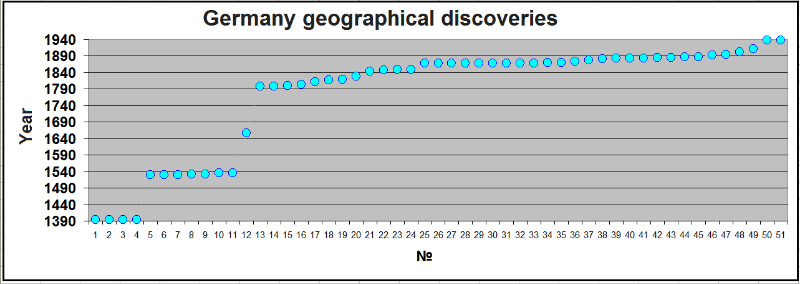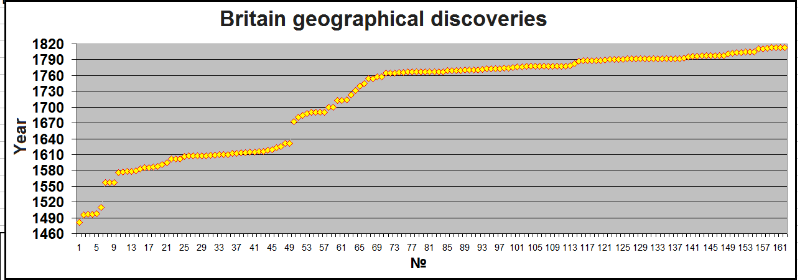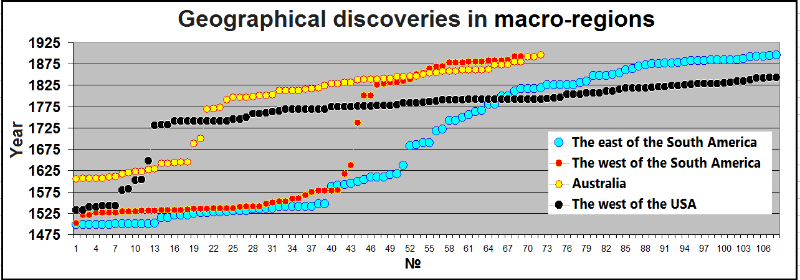Chronologie der geografischen Entdeckungen (by chispa1707)
05 Aug. 2019 16:13 #12053
von admin
-.-.-.-.-.-.-.-.-.-.-.-.-.-.-.-.-.-.-.-.-.-.-.-.-.-.-.-.-.-.-.-.-.-.-.-.-.-.-.-.-
Das einzige Kriterium der Zugehörigkeit eines Forschers / einer Forscherin
zu Geschichtskritik / Chronologiekritik (GChK) ist eine Leugnung
der Wahrheit der traditionellen Geschichte und Chronologie. (admin).
Chronologie der geografischen Entdeckungen (by chispa1707) wurde erstellt von admin
Chronology of geographical discoveries
Andrew Stepanenko
25 May, 2019
The table used for estimation was created by the authors of Big Soviet Encyclopedia D.M. Lebedev, I.P. Magidovich and Y.M. Svet. These were 1044 dated evidences. 476 more evidences were collected while the research was being written. In total, there are finally 1470.
German travellers investigated the world in three series with gap between the series is about 150 and 250 years.
And here are Britain geographical discoveries. The gap is insignificant - 30 years, however dynamics of discoveries changes considerably:
- In 1576-1631 0.73 discoveries in a year were made;
- In 1632-1764 0,16 discoveries in a year took place;
- In 1765-1820 1,90 discoveries in a year happened.
The middle 132-year-old period of reduction of density of events in 5-12 times has no explanation.
And these are Spain discoveries in several macro-regions. Total gap is 125-250 years. Therefore, Spain makes the whole series of discoveries in the south of the today USA until 1541, then there is a pause in 250 years and in 1792 – we see again discoveries in the same region.
In addition, here we see the Netherlands discoveries. The ships reach Australia, and during 50 years make the whole series of discoveries in the Pacific Ocean, and only then Dutches suddenly think better of it, and start to settle their bases in Southern Africa. And after all, to found transitional bases for repair and potable water supply is № 1 condition.
... Netherlands discoveries....
... France discoveries ...
...
This chronological problem is inherent not only to pioneers, but also to the discovered terra: huge parts of continents for decades remain without research - each macro-region in its time.
....
Here is a list of 100 regions having at least one gap in geographical discoveries lasting more than 99 years. Some gaps are easy to explain: so, expeditions could reach some places in the mountains of Khakassia for the first time only by 1883. However, more often the gap is around gulfs and straits, islands and peninsulas, that is, these objects are too remarkable not to notice them during 100-400 years.
Difference First Second Region
396 1493 1889 Vietnam
382 1511 1893 Kalimantan (Borneo)
381 1512 1893 Sulawesi and Sangihe islands
370 1500 1870 Malaysia
352 1516 1868 Guangdong (Canton)
350 1498 1848 Kenya
341 1517 1858 Uganda
324 1498 1822 Libya
322 1498 1820 Bengal
304 1549 1853 Colombia
297 1535 1832 Galapagos Islands
289 1570 1859 Mozambique
288 1581 1869 Colorado (CO)
284 1542 1826 Palau (Caroline Islands)
283 1600 1883 Republic of Khakassia
282 1511 1793 Sudan
267 1529 1796 South Korea
264 1535 1799 Venezuela
255 1609 1864 Democratic Republic of Congo (Zaire)
251 1627 1878 Indonesia
245 1527 1772 Hawaii (HI)
242 1616 1858 Malawi
234 1616 1850 Egypt
231 1604 1835 Guiana
225 1506 1731 Saint Helena, Ascension and Tristan da Cunha islands
223 1565 1788 Marshall Islands
220 1568 1788 Tuvalu
217 1648 1865 Madagascar
216 1616 1832 Chile
216 1654 1870 Mongolia
216 1614 1830 Nepal
216 1610 1826 Paraguay
214 1562 1776 Utah (UT)
205 1688 1893 Karachai-Cherkess Republic
202 1627 1829 Myanmar (Burma)
199 1649 1848 Amur Region
199 1568 1767 Solomon Islands
196 1624 1820 Punjab
195 1541 1736 Ecuador
193 1633 1826 Altai Territory
192 1494 1686 Japan
189 1637 1826 Peru
183 1557 1740 Uzbekistan
183 1609 1792 Georgia (GA)
179 1539 1718 Louisiana (LA)
178 1595 1773 Cook Islands
176 1557 1733 Russia
174 1604 1778 Saint Pierre and Miquelon
169 1515 1684 Bermudas
165 1639 1804 Honshu
162 1535 1697 California and Sonora
161 1643 1804 Hokkaido
158 1541 1699 Mexico
150 1616 1766 Wallis and Futunna Islands
149 1642 1791 Tasmania
148 1500 1648 Madagascar
147 1671 1818 Newfoundland and Labrador
145 1643 1788 Fiji
139 1616 1755 Argentina
138 1603 1741 California (CA)
137 1493 1630 Antilles
136 1722 1858 Sinkiang Uighur Region
135 1508 1643 Christmas Island
135 1599 1734 Arkhangelsk Region
135 1642 1777 Tonga
134 1600 1734 Yamalo-Nenetskiy Avtonomnyy Okrug
134 1604 1738 Nebraska (NE)
133 1513 1646 Chukchi Autonomous Okrug
130 1543 1673 Arkansas (AR)
129 1496 1625 England
127 1660 1787 Angola
127 1726 1853 Astrakhan Region
127 1716 1843 Tibet
127 1500 1627 Indonesia
127 1642 1769 New Zealand
125 1636 1761 India
124 1742 1866 Krasnoyarsk Region
124 1613 1737 Spitsbergen and Jan Mayen islands
123 1631 1754 East Canada
121 1518 1639 Amur Region
120 1686 1806 Arkansas (AR)
119 1497 1616 Wallis and Futunna Islands
116 1543 1659 Mississipi (MS)
115 1620 1735 Taimyr (Dolgan-Nenets) Autonomous Area
115 1524 1639 Honshu
114 1620 1734 Irkutsk Region
114 1497 1611 Republic of South Africa
110 1686 1796 Japan
109 1772 1881 Thailand
109 1669 1778 Oregon (OR)
106 1628 1734 Krasnoyarsk Region
106 1616 1722 French Polynesia
106 1503 1609 Seychelles
106 1616 1722 Samoa
106 1542 1648 Alaska (AK)
105 1618 1723 Gambia
104 1714 1818 Senegal
103 1739 1842 Taimyr (Dolgan-Nenets) Autonomous Area
100 1521 1621 Guam
100 1613 1713 Nova Scotia (Acadia)
Even a 30-year-old gap is a serious historical problem, and there are a lot of them (about 250), and it is almost one third of the total number of regions.
EXPLAINABLE FACTS
There is only one graph, which meaning we will try to explain. Here it is in a full form, and we will repeat it below, but in 25 year blocks - so it will be more understandable.
....
THE PROBLEM FORMULATION:
The clearness presented above is categorically insufficient for understanding of the basic problem of geographical discoveries chronology. We will specify its characteristics:
1. Chronological gaps in the series of geographical discoveries is 30-250 years that excludes their natural character.
2. Chronological gaps are inherent both to the pioneers, and the objects of their discoveries: during the most different time the most different powers stop their research of different macro-regions.
3. Even if we do not see obvious gaps, there is constantly a long-term decrease of intensity of geographical discoveries.
4. Seafarers of different countries make comparable in complexity voyages with gaps in hundreds years, and the historical substantiation of this paradox does not basically exist.
The situation could be explained by struggle for diplomatic priorities and mass redating of the historical documentation when the priority in geographical discoveries was necessary for the state.
INDIRECT INSTRUCTIONS
ABOUT ROUND-THE-WORLD TRAVELS
...
CONCLUSION
In the case with geographical discoveries, we deal with scale redating of enormous amount of the historical documentation. These event clusters are reorganized in the past in the whole amount, but it is impossible to solve the problem of similar complexity without any traces left. So the events still have duplicates, dated is correctly.
The theme “Chronology of the colonial goods” is closely connected with this research.
The database is used based on 154643 dated historical events, Excel-2007, 30,9 Mb, free download.
The whole article is here
Andrew Stepanenko
25 May, 2019
The table used for estimation was created by the authors of Big Soviet Encyclopedia D.M. Lebedev, I.P. Magidovich and Y.M. Svet. These were 1044 dated evidences. 476 more evidences were collected while the research was being written. In total, there are finally 1470.
German travellers investigated the world in three series with gap between the series is about 150 and 250 years.
And here are Britain geographical discoveries. The gap is insignificant - 30 years, however dynamics of discoveries changes considerably:
- In 1576-1631 0.73 discoveries in a year were made;
- In 1632-1764 0,16 discoveries in a year took place;
- In 1765-1820 1,90 discoveries in a year happened.
The middle 132-year-old period of reduction of density of events in 5-12 times has no explanation.
And these are Spain discoveries in several macro-regions. Total gap is 125-250 years. Therefore, Spain makes the whole series of discoveries in the south of the today USA until 1541, then there is a pause in 250 years and in 1792 – we see again discoveries in the same region.
In addition, here we see the Netherlands discoveries. The ships reach Australia, and during 50 years make the whole series of discoveries in the Pacific Ocean, and only then Dutches suddenly think better of it, and start to settle their bases in Southern Africa. And after all, to found transitional bases for repair and potable water supply is № 1 condition.
... Netherlands discoveries....
... France discoveries ...
...
This chronological problem is inherent not only to pioneers, but also to the discovered terra: huge parts of continents for decades remain without research - each macro-region in its time.
....
Here is a list of 100 regions having at least one gap in geographical discoveries lasting more than 99 years. Some gaps are easy to explain: so, expeditions could reach some places in the mountains of Khakassia for the first time only by 1883. However, more often the gap is around gulfs and straits, islands and peninsulas, that is, these objects are too remarkable not to notice them during 100-400 years.
Difference First Second Region
396 1493 1889 Vietnam
382 1511 1893 Kalimantan (Borneo)
381 1512 1893 Sulawesi and Sangihe islands
370 1500 1870 Malaysia
352 1516 1868 Guangdong (Canton)
350 1498 1848 Kenya
341 1517 1858 Uganda
324 1498 1822 Libya
322 1498 1820 Bengal
304 1549 1853 Colombia
297 1535 1832 Galapagos Islands
289 1570 1859 Mozambique
288 1581 1869 Colorado (CO)
284 1542 1826 Palau (Caroline Islands)
283 1600 1883 Republic of Khakassia
282 1511 1793 Sudan
267 1529 1796 South Korea
264 1535 1799 Venezuela
255 1609 1864 Democratic Republic of Congo (Zaire)
251 1627 1878 Indonesia
245 1527 1772 Hawaii (HI)
242 1616 1858 Malawi
234 1616 1850 Egypt
231 1604 1835 Guiana
225 1506 1731 Saint Helena, Ascension and Tristan da Cunha islands
223 1565 1788 Marshall Islands
220 1568 1788 Tuvalu
217 1648 1865 Madagascar
216 1616 1832 Chile
216 1654 1870 Mongolia
216 1614 1830 Nepal
216 1610 1826 Paraguay
214 1562 1776 Utah (UT)
205 1688 1893 Karachai-Cherkess Republic
202 1627 1829 Myanmar (Burma)
199 1649 1848 Amur Region
199 1568 1767 Solomon Islands
196 1624 1820 Punjab
195 1541 1736 Ecuador
193 1633 1826 Altai Territory
192 1494 1686 Japan
189 1637 1826 Peru
183 1557 1740 Uzbekistan
183 1609 1792 Georgia (GA)
179 1539 1718 Louisiana (LA)
178 1595 1773 Cook Islands
176 1557 1733 Russia
174 1604 1778 Saint Pierre and Miquelon
169 1515 1684 Bermudas
165 1639 1804 Honshu
162 1535 1697 California and Sonora
161 1643 1804 Hokkaido
158 1541 1699 Mexico
150 1616 1766 Wallis and Futunna Islands
149 1642 1791 Tasmania
148 1500 1648 Madagascar
147 1671 1818 Newfoundland and Labrador
145 1643 1788 Fiji
139 1616 1755 Argentina
138 1603 1741 California (CA)
137 1493 1630 Antilles
136 1722 1858 Sinkiang Uighur Region
135 1508 1643 Christmas Island
135 1599 1734 Arkhangelsk Region
135 1642 1777 Tonga
134 1600 1734 Yamalo-Nenetskiy Avtonomnyy Okrug
134 1604 1738 Nebraska (NE)
133 1513 1646 Chukchi Autonomous Okrug
130 1543 1673 Arkansas (AR)
129 1496 1625 England
127 1660 1787 Angola
127 1726 1853 Astrakhan Region
127 1716 1843 Tibet
127 1500 1627 Indonesia
127 1642 1769 New Zealand
125 1636 1761 India
124 1742 1866 Krasnoyarsk Region
124 1613 1737 Spitsbergen and Jan Mayen islands
123 1631 1754 East Canada
121 1518 1639 Amur Region
120 1686 1806 Arkansas (AR)
119 1497 1616 Wallis and Futunna Islands
116 1543 1659 Mississipi (MS)
115 1620 1735 Taimyr (Dolgan-Nenets) Autonomous Area
115 1524 1639 Honshu
114 1620 1734 Irkutsk Region
114 1497 1611 Republic of South Africa
110 1686 1796 Japan
109 1772 1881 Thailand
109 1669 1778 Oregon (OR)
106 1628 1734 Krasnoyarsk Region
106 1616 1722 French Polynesia
106 1503 1609 Seychelles
106 1616 1722 Samoa
106 1542 1648 Alaska (AK)
105 1618 1723 Gambia
104 1714 1818 Senegal
103 1739 1842 Taimyr (Dolgan-Nenets) Autonomous Area
100 1521 1621 Guam
100 1613 1713 Nova Scotia (Acadia)
Even a 30-year-old gap is a serious historical problem, and there are a lot of them (about 250), and it is almost one third of the total number of regions.
EXPLAINABLE FACTS
There is only one graph, which meaning we will try to explain. Here it is in a full form, and we will repeat it below, but in 25 year blocks - so it will be more understandable.
....
THE PROBLEM FORMULATION:
The clearness presented above is categorically insufficient for understanding of the basic problem of geographical discoveries chronology. We will specify its characteristics:
1. Chronological gaps in the series of geographical discoveries is 30-250 years that excludes their natural character.
2. Chronological gaps are inherent both to the pioneers, and the objects of their discoveries: during the most different time the most different powers stop their research of different macro-regions.
3. Even if we do not see obvious gaps, there is constantly a long-term decrease of intensity of geographical discoveries.
4. Seafarers of different countries make comparable in complexity voyages with gaps in hundreds years, and the historical substantiation of this paradox does not basically exist.
The situation could be explained by struggle for diplomatic priorities and mass redating of the historical documentation when the priority in geographical discoveries was necessary for the state.
INDIRECT INSTRUCTIONS
ABOUT ROUND-THE-WORLD TRAVELS
...
CONCLUSION
In the case with geographical discoveries, we deal with scale redating of enormous amount of the historical documentation. These event clusters are reorganized in the past in the whole amount, but it is impossible to solve the problem of similar complexity without any traces left. So the events still have duplicates, dated is correctly.
The theme “Chronology of the colonial goods” is closely connected with this research.
The database is used based on 154643 dated historical events, Excel-2007, 30,9 Mb, free download.
The whole article is here
-.-.-.-.-.-.-.-.-.-.-.-.-.-.-.-.-.-.-.-.-.-.-.-.-.-.-.-.-.-.-.-.-.-.-.-.-.-.-.-.-
Das einzige Kriterium der Zugehörigkeit eines Forschers / einer Forscherin
zu Geschichtskritik / Chronologiekritik (GChK) ist eine Leugnung
der Wahrheit der traditionellen Geschichte und Chronologie. (admin).
Bitte Anmelden um der Konversation beizutreten.
Ladezeit der Seite: 0.245 Sekunden





